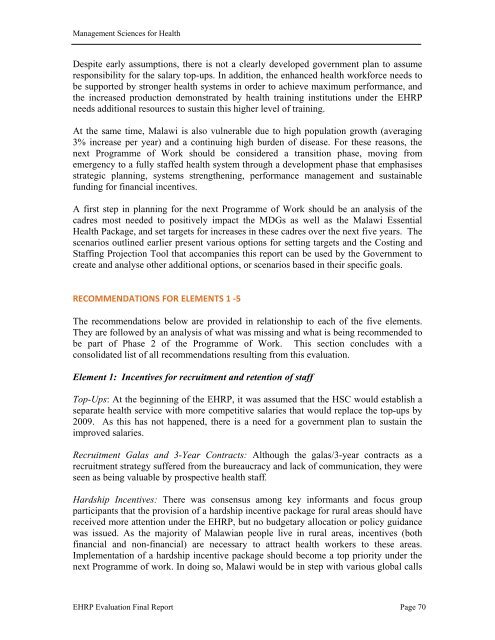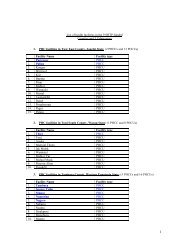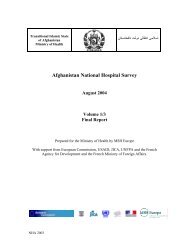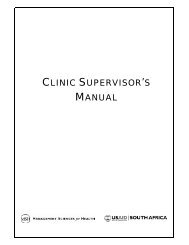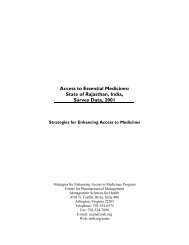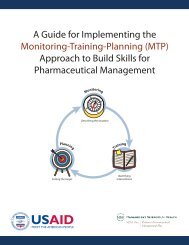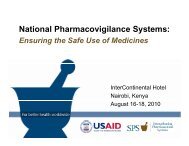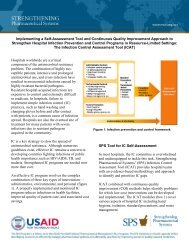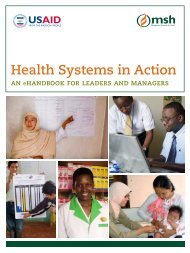Evaluation of Malawi's Emergency Human Resources Programme
Evaluation of Malawi's Emergency Human Resources Programme
Evaluation of Malawi's Emergency Human Resources Programme
Create successful ePaper yourself
Turn your PDF publications into a flip-book with our unique Google optimized e-Paper software.
Management Sciences for Health<br />
Despite early assumptions, there is not a clearly developed government plan to assume<br />
responsibility for the salary top-ups. In addition, the enhanced health workforce needs to<br />
be supported by stronger health systems in order to achieve maximum performance, and<br />
the increased production demonstrated by health training institutions under the EHRP<br />
needs additional resources to sustain this higher level <strong>of</strong> training.<br />
At the same time, Malawi is also vulnerable due to high population growth (averaging<br />
3% increase per year) and a continuing high burden <strong>of</strong> disease. For these reasons, the<br />
next <strong>Programme</strong> <strong>of</strong> Work should be considered a transition phase, moving from<br />
emergency to a fully staffed health system through a development phase that emphasises<br />
strategic planning, systems strengthening, performance management and sustainable<br />
funding for financial incentives.<br />
A first step in planning for the next <strong>Programme</strong> <strong>of</strong> Work should be an analysis <strong>of</strong> the<br />
cadres most needed to positively impact the MDGs as well as the Malawi Essential<br />
Health Package, and set targets for increases in these cadres over the next five years. The<br />
scenarios outlined earlier present various options for setting targets and the Costing and<br />
Staffing Projection Tool that accompanies this report can be used by the Government to<br />
create and analyse other additional options, or scenarios based in their specific goals.<br />
RECOMMENDATIONS FOR ELEMENTS 1 ‐5<br />
The recommendations below are provided in relationship to each <strong>of</strong> the five elements.<br />
They are followed by an analysis <strong>of</strong> what was missing and what is being recommended to<br />
be part <strong>of</strong> Phase 2 <strong>of</strong> the <strong>Programme</strong> <strong>of</strong> Work. This section concludes with a<br />
consolidated list <strong>of</strong> all recommendations resulting from this evaluation.<br />
Element 1: Incentives for recruitment and retention <strong>of</strong> staff<br />
Top-Ups: At the beginning <strong>of</strong> the EHRP, it was assumed that the HSC would establish a<br />
separate health service with more competitive salaries that would replace the top-ups by<br />
2009. As this has not happened, there is a need for a government plan to sustain the<br />
improved salaries.<br />
Recruitment Galas and 3-Year Contracts: Although the galas/3-year contracts as a<br />
recruitment strategy suffered from the bureaucracy and lack <strong>of</strong> communication, they were<br />
seen as being valuable by prospective health staff.<br />
Hardship Incentives: There was consensus among key informants and focus group<br />
participants that the provision <strong>of</strong> a hardship incentive package for rural areas should have<br />
received more attention under the EHRP, but no budgetary allocation or policy guidance<br />
was issued. As the majority <strong>of</strong> Malawian people live in rural areas, incentives (both<br />
financial and non-financial) are necessary to attract health workers to these areas.<br />
Implementation <strong>of</strong> a hardship incentive package should become a top priority under the<br />
next <strong>Programme</strong> <strong>of</strong> work. In doing so, Malawi would be in step with various global calls<br />
EHRP <strong>Evaluation</strong> Final Report Page 70


